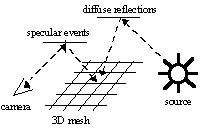|
|
Contents Introduction Lightscape System Specter System Radiance System Scenes for Comparison Experimental Results Conclusion Acknowledgments |
|
A.B. Khodulev, E.A. Kopylov
|
|
Contents Introduction Lightscape System Specter System Radiance System Scenes for Comparison Experimental Results Conclusion Acknowledgments |
|
References in this chapter are to LVS User Manual.
LVS supports only three classes of light sources: point, linear, and area lights (ref. to ch.2, p.67). Area lights are implemented by means of self-luminance attribute that can be assigned to any object in scene.
The advanced Lighting Module of Lightscape provides the functionality to import or define any general lighting distribution using the IES format (ref. to ch.2, p.70).
The absence of parallel light source in Lightscape is compensated partially by mechanism of daylight usage in a model (the North direction, Latitude and Longitude of a model location, and the Greenwich Mean Time should be specified, ref. to ch.2, p.76).
LVS supports selfluminous objects and texture assignment.
In LVS the overall character of the material is determined by the combination of the specular and the diffuse components (ref. to ch.2, p.48). To be precise, material definition consists of diffuse and specular colors, specular reflectivity that causes reflective effects during ray tracing, relative transparency that produces colored shadows based on the material's diffuse color, and index of refraction (ref. to Reference Guide, p.178).
So, we see rather simple local reflectance model that supports only perfect diffuse (Lambertian) reflectivity, ideal specular reflectivity / transparency and refraction. More complex than perfect Lambertian reflectance distribution functions are not supported.
The radiosity algorithms implemented in LVS produce the simulations of diffuse light energy propagation in an environment (ref. to ch.1, p.3). Total control based on progressive radiosity algorithms, so called design, means modification of a material or light source definition and then new results will be rapidly compensated and displayed without having to start the process over (ref. to ch.1, p.4). The final result of simulation is achieved after process of rendering that is the backward ray tracing algorithm, from each pixel and into the scene.
This global illumination model is restricted by the following scheme of light propagation (ref. to ch.1, p.7-11):

The representative set of real scenes demonstrates that this model is not efficient for attaining natural realism in produced images. The main disadvantages of the illumination model are the following:
In particular, the specular-to-diffuse light transfer is not supported at all. In practice it means that diffuse surface illumination by light reflected in mirror or refracted by some transparent smooth object is not taken into account.
The control of simulation accuracy in LVS is based on mechanism of illumination maps subdivision (3D mesh) that has the most direct impact on the quality and efficiency of simulation, and subdivision of light source area (Source Accuracy, ref. to ch.3, p.97). The subdivision is adaptive: areas with greater gradient of illuminance are subdivided deeper. Maximum (initial) and minimum sizes of subdivided mesh elements are user-controlled parameters. No tools are provided for quantitative estimates of the simulation accuracy.
Two main forms of output data exist: image and numerical values of luminance / illuminance.
LVS can generate image files only in the native SGI raster RGB format (ref. to ch.5, p.126). The execution of monitor calibration is recommended as simple gamma changing by SGI tool (ref. to ch.5, p.127). Also LVS allows to manipulate brightness and contrast of the image displayed on the monitor directly by slider, it does not affect result of simulation (ref. to Reference Guide, p.202). Images in color fringes are available.
In restricted LVS version available for us the only way to extract results of simulation in numerical form is to mouse click the point of interest, then system returns luminance / illuminance values and some additional information. Surely this way is sometimes rather inconvenient. Complete version of LVS provides capability for tabular data output but we can not analyze it.
A lot of LVS operations are available interactively. Any attribute of material or light source can be changed; moreover, LVS supports incremental mode of lighting simulation after local change of attributes: it uses previous results to get solution for changed attributes faster but less accurately than if all were calculated from scratch.
Interactive change of observer (camera) and interactive interrogation of simulation results are available. Speed of image redrawing in process of camera movement is rather fast.
We should conclude this chapter by the remark that due to the physical incompleteness and incorrectness of light transfer (global and local mechanisms) and practical absense of accuracy control which largely stems from that incompleteness, Lightscape Visualization System usage in lighting simulations, especially in industrial applications, is severely limited if possible at all. See also experimental data in the "Experimental Results" section
|
|
Contents Introduction Lightscape System Specter System Radiance System Scenes for Comparison Experimental Results Conclusion Acknowledgments |
|

|
|
| © Copyright 1996 Andrei B. Khodulev, Edward A. Kopylov.- All Rights Reserved | [Home] |